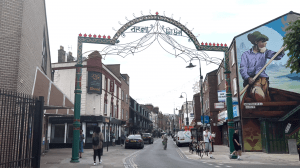My trip to the iconic Brick Lane neighborhood in the East End of London was a thrilling and diverse experience. To being our tour, we started at landmark spots that hold the history of the first Indian immigrants to the area. The St. Botolph’s Church without Aldgate at first seemed like an unusual place to start, but it is in fact an important to the first Bengali immigrants. The early Indian diaspora in Britain is often restricted to 18th century Indian travelers, diplomats, or entrepreneurs who reached London after the British conquest of Bengal. But to challenge the brute rhetoric, we need to cultivate deeper historical awareness about the Indians who lived in London nearly 500 years ago. Some of these immigrants were converts to Christianity because of their contact with Europeans. Their names were recorded in the church of St. Botolphs Aldgate, one being James, a servant of James Duppa, the beer-brewer. Another significant stop was at No. 13 Sandy’s Row. Bengalis played an important role in British seafaring. Many of them served in the Navy and the Army in the First World War. However, after the war many Bengali lascars were left without employment. Many settled in London and entered the catering or clothing industry in this part of town because of the existing Bengali presence. But some sailors faced a lot of struggles coming to London and needed help figuring things out. This house was the home to Ayub Ali Master from 1945 to 1959 and here he opened his home to sailors to provide lodging and many types of support. He later set up the Indian Seamen’s Welfare League. Bengali lascars also had a huge role in the Second World War but their contribution is often overlooked, as they were never given reparations for their sacrifices. 6,000 Indian seamen died. Ayub Ali also later became president of the All-India Muslim League which later plays an important role in the independence of India with its leader Muhammad Ali Jinnah. After visiting the important landmark spots, we made our way to the physical Brick Lane. Here, I simultaneously experienced the past and the future of Banglatown. At the beginning of the lane, there is a large cluster of Bangladeshi businesses, including many cafes and restaurants. Bengali immigrants to London have held this area for many years as a large remembrance to their Indian identity. However, as one walks further down the lane, the stores along the road become more modern and mainstream. As a group, we had the pleasure of dining at a traditional Indian restaurant. This was my first time trying Indian food, and I very much enjoyed the food. I am grateful that I got to not only visually visit the neighborhood, but physically experience a piece of the culture. The number of curry houses and Bengali-owned businesses along Brick Lane has been significantly declining over the years. This is a sad result of a multitude of reasons. Although, one can still feel the presence, memories, and pieces of history of Indian immigrants along Brick Lane, the question creeps in one’s mind of how long this will remain with the rapid changes occurring.
Lydia Poche
https://beyondbanglatown.org.uk/globe/
https://www.gq-magazine.co.uk/politics/article/brick-lane-curry-houses-bangladeshi


